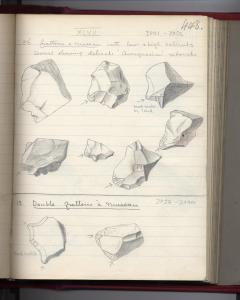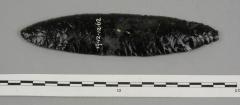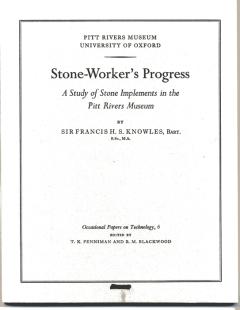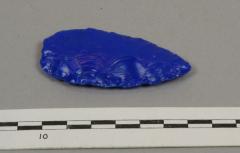ENGLAND: THE OTHER WITHIN
Analysing the English Collections at the Pitt Rivers Museum
Lithic technology at the Pitt Rivers Museum
Alison Petch,
Researcher 'The Other Within' project
Interest in stone tool technology obviously pre-dates the Pitt Rivers Museum. Many nineteenth-century archaeologists and anthropologists were interested in what stone tools could tell about the early development of humans, and also experimented making stone tools themselves. An example might be John Evans (1823-1908), numismatist, archaeologist and paper manufacturer, who taught Augustus Henry Lane Fox Pitt Rivers to knap flints. This article will not, however, focus on the wider picture but instead will concentrate on the work in this area carried out by the man who donated the founding collection to the University of Oxford, and the Pitt Rivers Museum staff who followed him.
Pitt Rivers' founding collection and stone tool technology before 1884
Stone tool technology was not one of Pitt-Rivers principal interests but he did learn to knap flint and he also field walked to find stone tools on the surface. He donated a large collection of stone tools, from all over the world to the Pitt Rivers Museum.
Find out more about his work on stone tools here
Find out more about his field walking here
Pitt Rivers' practical interest in stone tool making, and his interest in collecting stone tools was carried on by the staff who worked at the Pitt Rivers Museum in Oxford.
Work in the Pitt Rivers Museum on stone tool technology
Most of the people who worked in the Pitt Rivers Museum (or who volunteered there) were interested in stone tool technology. For a few of them, it was the main focus of their museum work.
Edward Burnett Tylor was very involved in the early establishment of the Pitt Rivers Museum in Oxford. He was also interested in stone tool technology, particularly about what it might tell us about Tasmanian culture. Henry Balfour dominated the Museum between 1890 and 1939. He not only ran it, and taught the diploma students but also chose and arranged the new displays, appointed the junior staff and volunteers. In other words he set the agenda for the work of the Museum between these dates. Henry Balfour's work on stone tools is summarised here. He encouraged Sir Francis Knowles to continue his work on stone tool technology in the Museum after ill-health forced him to retire from an active career of his own.
This encouragement continued under the next Curator, Thomas Kenneth Penniman. He continued to encourage Knowles who started putting his knowledge to use organizing museum displays of particular forms of stone tools, he also encouraged Alfred Schwartz Barnes to volunteer at the Museum. He also encouraged staff and volunteers to publish about technology in the Museum's Occasional Papers series. In fact, Penniman integrated stone tool technology into the teaching in the Museum, in his first Museum Annual Report, he writes:
Lectures on Archaeology with modern ethnological parallels, and on the Useful and Aesthetic Arts of Primitive Peoples have been given to Diploma students and others by the Acting Curator and Miss Blackwood. A Practical Museum course has been started, and certain working models purchased. Several volunteers have been found to assist next year in showing students how to make flint implements, and in teaching them to use the various appliances in use among primitive peoples. Such work is a most important preliminary to a study of their ethnological significance, and leads to a deeper understanding of peoples, especially among those being trained for field-work. [Museum Annual Report 1938-9]
Other staff at this time who also worked in this field included Beatrice Blackwood. After Penniman retired other museum staff were interested including Bryan Cranstone. Today staff and visiting researchers still work on the stone tool collections. Currently Matthew Nicholas, an Institute for Archaeologists intern at the Museum, is working on the Oxfordshire archaeological collections, including all the stone tools from the county in the Museum. To find out more about the bursary which funds Matt see here.
Find out more about the Pitt Rivers Museum's stone tool collections here.



